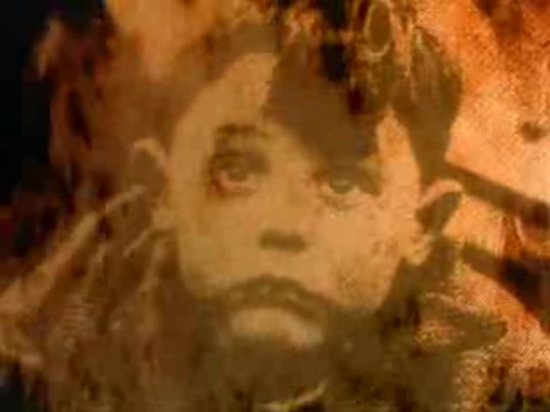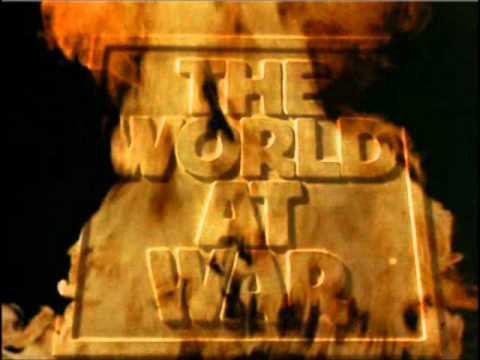It was the the theme music that did it, Carl Davis’ doomy, portentous clarinet and string eddies. It was that, and the programme’s ident of orange flames – colours wan as they were on all telly from the 70s that you watched in the 80s – consuming photographs of people, a young boy. Then the stern gravitas of Sir Lawrence Olivier’s narration, before footage of diving planes, crouching soldiers, ships see-sawing up out of the water, fountains of mud and disintegrating buildings. In the days before modern special effects or the hours of archive footage now available on YouTube, all of this made The World At War so vivid, and those introductory moments were the first indication that this was a very different kind of television programme. Today, four decades after its initial transmission, The World At War stands out as a landmark moment in the history of ITV, a documentary that set a new standard, and one that few have surpassed ever since.
The World At War, total running time nearly 23 hours, was commissioned in 1969 and took thousands of hours of research before the first episode was broadcast on October 31st 1973. The series, which ended in May 1974, was one of the most expensive television programmes that ITV had then produced to date, costing £900,000. Yet the effort spent on tracking down the interviewees – anyone from Albert Speer to Gerald Durrell among the ordinary soldiers and civilians – all contributed to a programme that was devastatingly simple, brutally and poignantly effective. The first episode opened thus: "On a summer day in 1944, the soldiers came…" It was the story of the village of Oradour-sur-Glane, where the SS committed a massacre of French civilians shortly after D-Day, locking the women and children of the community in the church and setting it on fire, while shooting the men in nearby barns. This was a long way from the Sunday afternoon war films that, until then, had been my experience of the Second World War on the television screen. For a pre-teen sat obsessing over Airfix kits in the late 80s, The World At War suddenly made the moulded pieces take on a whole new meaning. Here were those men you’d painted into their cockpits, here were the women they were dropping their bombs on. Here were the things that were never recreated in handily craftable form – HMS Hood exploded with three survivors, a paper Tokyo become instant ash, a Hornby train to Auschwitz.
The World At War was a programme that achieved what most museums make a cliché – a living history, for the first time giving a voice to the war’s participants, victors and losers, major and minor players alike. Everyone looked a bit like your grandparents, or their friends, or people from just down the road, even the likes of Albert Speer – no ham-necked Nazi monster of cliché, but an man ageing in Spandau Prison. There was Hitler’s secretary Traudl Junge, in her yolk yellow shirt and patterned scarf. The soldiers, chests covered in the hollow glow of the medals of the victors. Toshikuzu Kase the Japanese Cabinet Secretary in his striped shirt and tie. The female Soviet soldier who participated in the raising of the hammer and sickle over the Reichstag, a Nora Batty from across the Vistula. They became real connections to those people who, as a child, you knew had ‘been in the war’, but wouldn’t talk about it. It was there as this part of anyone old that made them somehow different from the rest of us, their stories – when you did get them – to be valued. There was my granny from Loughton in Essex, where the family across the road were killed in their air raid shelter as she watched the London docks ablaze from Epping Forest. She was evacuated to the Cotswolds, where rabbits would be shot from the farmhouse window during the washing up.
"The shooting, we know how they sound. The little boy of Goebbels, he noticed how it sounds. That was a bullseye," says Traudl Junge of Hitler’s suicide during the episode covering those unimaginable final days in the Reich Chancellory bunker. This was revolutionary at the time – the inclusion of ‘enemy’ voices in the narrative of British and American victory. Also featured were the likes of Grand Admiral Donitz, who after that date had become German head of state and surrendered to the allies in May 1945, and fighter ‘ace’ Adolf Galland. Given that this the programme was filmed at the height of the Cold War, the focus on the Soviet blood sacrifice was also bold.
Yet some of this does jar with modern sensibilities. Take the episode on the war in the Pacific, and the language used to describe how the Japanese were such a difficult foe: "Ordinary citizens subjected themselves to regimentation of thought and act. The inculcation of patriotism began in infancy. From their earliest days Japanese children prepared mind and body to serve a cause greater than themselves… nation, emperor." There’s then footage of pre-pubescent youth "joining the airforce for a day". This can look problematic to modern eyes, despite part of the reason for many of World War Two’s atrocities being the result of neo-occult fanaticism. Yet it did, for the first time, inform people about what had occurred in those far off sectors of the war that might previously have felt remote. These are the things that have since largely been forgotten by younger generations. We have angst over Dresden, but in recent years there has been little discussion of the raids on Japan by the American B29 Superfortresses that used conventional weapons to cause far more destruction than both atomic bombs. As Olivier intones: "Tokyo was a charred wasteland. Only steel and concrete survived. 16 square miles of the capital were flattened. In one raid, in one night, over 70,000 perished."
It’s a long way from the tone of most documentaries about the Second World War today – all rather Keep Calm & Carry On, at times jingoistic, or focusing purely on the technology used to kill in a way that makes me feel rather uncomfortable, especially when you get to some of the cable channels. Take, for example, Jeremy Clarkson’s narration of last week’s documentary on disastrous Arctic convoy PQ 17, all faux gravitas and jokes about American ships carrying lard.
This is partly why, in recent years, and among many people I know on the liberal left of the spectrum, it has become seen as suspect to have an interest in war, to read about the cold facts of movement of iron and associate with them the casualty figures ground beneath, as if in some way this is prurient, even fetishistic. The World At War counters this blinkered, even dangerous view. It’s a programme important and remarkable not just as a document – after all, since the fall of the Soviet Union years after this was filmed, new stories and new ‘truths’ have come to light – but as one of the most important artistic, historical and documentary statements on why this kind of war, why all war, must be studied and never forgotten.
Every episode would end in the same way, with the final shot of archive material – a woman moving through broken cityscape, the waves of the North Atlantic – becoming frozen, grayscale, pixelated, individuals lost and destroyed in the blur of a history that never ended. World War Two was born in the First World War, which was born in those before, all of which were the ancestors of the Cold War, and then the so-called War On Terror. The World At War was a title that, unintended by its makers, captured six years of a violent human continuum. It’s worth noting the importance of the programme’s refusal to glorify conflict and victors in contrast to Michael Gove’s recent comments on the First World War.
World War Two had a global impact unlike anything before or since. Paradoxically, it was an instrument of repression and freedom, the cause of the fall of the British Empire and the birth of American economic and cultural hegemony, not to mention our welfare state. In World War Two’s violence (violence is always an expedient of technology) was born computing, commercial air travel, space exploration, mass communication… As such, it necessitated a programme with the scope, ambition, and – for the era – even-handedness as The World At War. The voices that narrated The World At War, those lucky survivors, are now all silent. We ought to learn from them. As Rwanda, Bosnia, Palestine, Sudan, Algeria, Vietnam, Korea, Afghanistan, Georgia, Sri Lanka, Northern Ireland and Indonesia show, we won’t. "So it goes", as Kurt Vonnegut wrote. As the continuity announcer on Yesterday – the channel where The World At War is now screened – has it: "Fanatical in their defence, the Japanese battle in vain against the Americans tomorrow, when The World At War moves to the Pacific. Next this morning, Countryfile."



